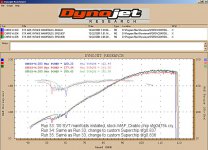Chris; are you still running secondaries ?
looks like the torque curve would move up low down, if you at least took out the brass blades.
Do you think the PSI would take longer to build if you took the secondaries out ? ... to get more boost low down, is that why you moved up to the next pulley upgrade ? .... G.
looks like the torque curve would move up low down, if you at least took out the brass blades.
Do you think the PSI would take longer to build if you took the secondaries out ? ... to get more boost low down, is that why you moved up to the next pulley upgrade ? .... G.

